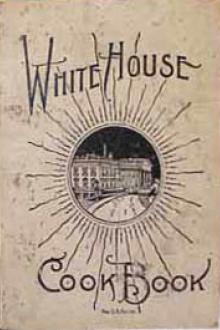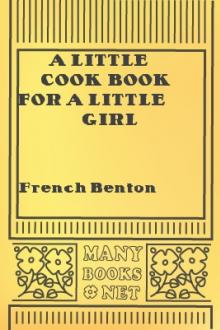The Whitehouse Cookbook (1887), Hugo Ziemann [world of reading .TXT] 📗

- Author: Hugo Ziemann
- Performer: -
Book online «The Whitehouse Cookbook (1887), Hugo Ziemann [world of reading .TXT] 📗». Author Hugo Ziemann
Lemon syrup is made in the same way, except that you scald the lemons and squeeze out the juice, allowing rather more sugar.
ORANGE MARMALADE.
Allow pound for pound. Pare half the oranges and cut the rind into shreds. Boil in three waters until tender and set aside. Grate the rind of the remaining oranges; take off, and throw away every bit of the thick white inner skin; quarter all the oranges and take out the seeds. Chop or cut them into small pieces; drain all the juice that will come away without pressing them over the sugar; heat this, stirring until the sugar is dissolved, adding a very little water, unless the oranges are very juicy. Boil and skim five or six minutes; put in the boiled shreds and cook ten minutes; then the chopped fruit and grated peel, and boil twenty minutes longer. When cold, put into small jars, tied up with bladder or paper next the fruit, cloths dipped in wax over all. A nicer way still is to put away in tumblers with self-adjusting metal tops. Press brandied tissue paper down closely to the fruit.
LEMON MARMALADE
Is made as you would prepare orange—allowing a pound and a quarter of sugar to a pound of the fruit, and using but half the grated peel.
RAISINS. (A French Marmalade.)
This recipe is particularly valuable at seasons when fruit is scarce. Take six fine large cooking apples, peel them, put them over a slow fire, together with a wine-glass of Medeira wine and half a pound of sugar. When well stewed, split and stone two and a half pounds of raisins, and put them to stew with the apples and enough water to prevent their burning. When all appears well dissolved, beat it through a strainer bowl, and lastly through a sieve. Mold, if you like, or put away in small preserve jars, to cut in thin slices for the ornamentation of pastry, or to dish up for eating with cream.
STRAWBERRY JAM.
To each pound of fine and not too ripe berries, allow three-quarters of a pound of sugar. Put them into a preserving pan and stir gently, not to break up the fruit; simmer for one-half hour and put into pots air-tight. An excellent way to seal jellies and jams is as the German women do: cut round covers from writing paper a half-inch too large for the tops, smear the inside with the unbeaten white of an egg, tie over with a cord, and it will dry quickly and be absolutely preservative. A circular paper dipped in brandy and laid over the toothsome contents before covering, will prevent any dampness from affecting the flavor. I have removed covers heavy with mold to find the preserve intact.
GOOSEBERRY JAM.
Pick the gooseberries just as they begin to turn. Stem, wash and weigh. To four pounds of fruit add half a teacupful of water; boil until soft and add four pounds of sugar and boil until clear. If picked at the right stage the jam will be amber colored and firm, and very much nicer than if the fruit is preserved when ripe.
BRANDIED PEACHES OR PEARS.
Four pounds of fruit, four pounds of sugar, one pint of best white brandy. Make a syrup of the sugar and enough water to dissolve it. Let this come to a boil; put the fruit in and boil five minutes. Having removed the fruit carefully, let the syrup boil fifteen minutes longer, or until it thickens well; add the brandy and take the kettle at once from the fire; pour the hot syrup over the fruit and seal. If, after the fruit is taken from the fire, a reddish liquor oozes from it, drain this off before adding the clear syrup. Put up in glass jars. Peaches and pears should be peeled for brandying. Plums should be pricked and watched carefully for fear of bursting.
RASPBERRY JAM.
To five or six pounds of fine red raspberries (not too ripe) add an equal quantity of the finest quality of white sugar. Mash the whole well in a preserving kettle; add about one quart of currant juice (a little less will do) and boil gently till it jellies upon a cold plate; then put into small jars; cover with brandied paper and tie a thick white paper over them. Keep in a dark, dry and cool place.
Blackberry or strawberry jam is made the same way, leaving out the currant juice.
A NEW WAY OF KEEPING FRUIT.
It is stated that experiments have been made in keeping fruit in jars covered only with cotton batting, and at the end of two years the fruit was sound. The following directions are given for the process: Use crocks, stone butter-jars or any other convenient dishes. Prepare and cook the fruit precisely as for canning in glass jars; fill your dishes with fruit while hot and immediately cover with cotton batting, securely tied on. Remember that all putrefaction is caused by the invisible creatures in the air. Cooking the fruit expels all these, and they cannot pass through the cotton batting. The fruit thus protected will keep an indefinite period. It will be remembered that Tyndall has proved that the atmospheric germs cannot pass through a layer of cotton.
MACEDOINES.
Suspend in the centre of the jelly mold a bunch of grapes, cherries, berries, or currants on their stems, sections of oranges, pineapples, or brandied fruits, and pour in a little jelly when quite cold, but not set. It makes a very agreeable effect. By a little ingenuity you can imbed first one fruit and then another, arranging in circles, and pour a little jelly successively over each. Do not re-heat the jelly, but keep it in a warm place, while the mold is on ice and the first layers are hardening.
Berries and all ripe, mellow fruit require but little cooking, only long enough for the sugar to penetrate. Strew sugar over them, allow them to stand a few hours, then merely scald with the sugar; half to three-quarters of a pound is considered sufficient. Harder fruits like pears, quinces, etc., require longer boiling. The great secret of canning is to make the fruit or vegetable perfectly air-tight. It must be put up boiling hot and the vessel filled to the brim.
Have your jars conveniently placed near your boiling fruit, in a tin pan of hot water on the stove, roll them in the hot water, then fill immediately with the hot, scalding fruit, fill to the top, and seal quickly with the tops, which should also be heated; occasionally screw down the tops tighter, as the fruit shrinks as it cools, and the glass contracts and allows the air to enter the cans. They must be perfectly air-tight. The jars to be kept in a dark, cool, dry place.
Use glass jars for fruit always, and the fruit should be cooked in a porcelain or granite-iron kettle. If you are obliged to use common large-mouthed bottles with corks, steam the corks and pare them to a close fit, driving them in with a mallet. Use the following wax for sealing: One pound of resin, three ounces of beeswax, one and one-half ounces of tallow. Use a brush in covering the corks and as they cool, dip the mouth into the melted wax. Place in a basin of cold water. Pack in a cool, dark and dry cellar. After one week, examine for flaws, cracks or signs of ferment.
The rubber rings used to assist in keeping the air from the fruit cans sometimes become so dry and brittle as to be almost useless. They can be restored to normal condition usually by letting them lie in water in which you have put a little ammonia. Mix in this proportion: One part of ammonia and two parts water. Sometimes they do not need to lie in this more than five minutes, but frequently a half hour is needed to restore their elasticity.
CANNED PEACHES.
To one pound of peaches allow half a pound of sugar; to six pounds of sugar add half a tumbler of water; put in the kettle a layer of sugar and one of peaches until the whole of both are in. Wash about eight peach leaves, tie them up and put into the kettle, remembering to take them out when you begin to fill up the jars. Let the sugared fruit remain on the range, but away from the fire, until upon tipping the vessel to one side you can see some liquid; then fill the jars, taking them out of hot water into which they were put when cold, remaining until it was made to boil around them. In this way you will find out if the glass has been properly annealed; for we consider glass jars with stoppers screwing down upon India-rubber rings as the best for canning fruit in families. They should be kept in a dark closet; and although somewhat more expensive than tin in the first instance, are much nicer and keep for years with careful usage.
Fruit must be of fine flavor and ripe, though not soft, to make nice canned fruit.
Peaches should be thrown into cold water as they are peeled, to prevent a yellowish crust.
CANNED GRAPES.
There is no fruit so difficult to can nicely as the grape; by observing the following instructions you will find the grapes rich and tender a year from putting up. Squeeze the pulp from the skin, as the seeds are objectionable; boil the pulp, until the seeds begin to loosen, in one kettle, having the skins boiling, in a little water, hard in another kettle, as they are tough. When the pulp seems tender, put it through the sieve; then add the skins, if tender, with the water they boil in, if not too much. We use a large coffeecupful of sugar for a quart can; boil until thick and can in the usual way.
CANNED STRAWBERRIES.
After the berries are picked over, let as many as can be put carefully in the preserve kettle at once be placed on a platter. To each pound of fruit add three-fourths of a pound of sugar; let them stand two or three hours, till the juice is drawn from them; pour it into the kettle and let it come to a boil and remove the scum which rises; then put in the berries very carefully. As soon as they come thoroughly to a boil put them in warm jars and seal while boiling hot.
TO CAN QUINCES.
Cut the quinces into thin slices like apples for pies. To one quart jarful of quince, take a coffeesaucer and a half of sugar and a coffeecupful of water; put the sugar and water on the fire, and when boiling put in the quinces; have ready the jars with their fastenings, stand the jars in a pan of boiling water on the stove, and when the quince is clear and tender put rapidly into the jars, fruit and syrup together. The jars must be filled so that the syrup overflows, and fastened up tight as quickly as possible.
CANNED PINEAPPLE.
For six pounds of fruit, when cut and ready to can, make syrup with two and a half pounds of sugar and nearly three pints of water; boil syrup five minutes and skim or strain if necessary; then add the fruit and let it boil up; have cans hot, fill and shut up as soon as possible. Use the





Comments (0)